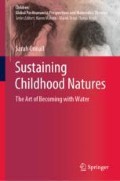Abstract
I am sitting by a window at a small desk looking over our garden . I am in our shack of a house, a walk from the Southern Ocean’s Bass Strait, and the tidal estuarine embayment of Western Port, Victoria, Australia. In the last four years, I have spent time with practicing artists who create artworks of waterways, on waterways and with waterways while I critically engage with singing this coastal confluence of rivers, creeks, bay and ocean into health. I am a river her self, washing down a gully, and disrupting banks. Water body, I am washing over rocks. A little of me is left behind and a little of them is drawn into me along the way. I am part of the planet. I am the planet.
Access this chapter
Tax calculation will be finalised at checkout
Purchases are for personal use only
Notes
- 1.
This painting, ‘Collonaides rock II’ (acrylic on paper, 2013), is by Mikala Peters and published with permission.
- 2.
Bodyplaceblogposts are largely published without editing. See ‘A Note’ section for more information.
- 3.
Tobey Henry of Banyule City Council and Melanie Smith of Melbourne Water, and I were part of a research project into the role of art in Waterwatch education; I worked with Angela Foley during my first instance of investigating art-making in environmental education programs when we, at Merri Creek Management Committee (MCMC), used photography in Waterwatch sessions with primary-aged children. This program element was extended at Werribee Plains Waterwatch.
- 4.
The Space, Place, Body research group is made up of doctoral students supervised by Margaret Somerville.
- 5.
This painting, Western Port unknown i (oil on canvas, ~2011), by Robyn Carter, is published with permission.
- 6.
These photographs and corresponding paintings, ‘Collonaides (I and II)’ are created by Mikala Peters (acrylic on paper, 2013), and published with permission.
- 7.
The artworks in this blogpost are of ‘everyday life with edith’ (photographs, 2013), Sarah Crinall.
- 8.
Also referred to as resources in this study.
References
Barad, K. (2010). Quantum entanglements and hauntological relations. Derrida Today, 3(2), 240–268.
Barad, K. (2012, Summer). Intra-actions: Interview of Karen Barad by Adam Kleinmann. Milan, Italy: Mousse Magazine, 13. Retrieved from https://www.academia.edu/1857617/_Intra-actions_Interview_of_Karen_Barad_by_Adam_Kleinmann_.
Bowers, C. A. (2008). Why a critical pedagogy of place is an oxymoron. Environmental Education Research, 14(3), 325–335.
Carter, P. (2004). Material thinking. Melbourne, Australia: Melbourne University Press.
Crinall, S. M. (2017). Blogging art and sustenance: Artful everyday life (making) with water (Doctoral Dissertation). Sydney, Australia: Western Sydney University.
Crinall, S., & Henry, T. (2008). Waterwatch and art: ‘Creating’ space for students to understand science and connect with waterways. International Journal for Environmental, Cultural, Ecological and Social Sustainability, 4(6), 55–64.
Gannon, S. (2011). Walking my way back home. In M. Somerville, B. Davies, K. Power, S. Gannon, & P. De Carteret (Eds.), Place pedagogy change (pp. 45–50). Rotterdam, The Netherlands: Sense Publishers.
Grosz, E. (2005). Time travels: Feminism, nature and power. Durham & London, UK: Duke University Press.
Grosz, E. (2011). Becoming undone. Durham & London, UK: Duke University Press.
Gruenewald, D. A. (2003a). The best of both worlds: A critical pedagogy of place. Educational Researcher, 32(4), 3–12.
Gruenewald, D. A. (2003b). Foundations of place: A multidisciplinary framework for place-conscious education. American Educational Research Journal, 40(3), 619–654.
Kristeva, J. (1986). Women’s time. In T. Moi (Ed.), The Kristeva reader (pp. 187–213). Oxford, UK: Blackwell Publishers.
Lovett, S. (2006). Managing knowledge for natural resources management outcomes. Proceedings vegetation futures conference. Greening Australia. Retrieved from www.greeningaustralia.org.au.
McKenzie-Mohr, D. (1999). Fostering sustainable behaviour: An introduction to community-based social marketing. Gabriola Island, BC, Canada: New Society Publishers.
Moi, T. (Ed.). (1986). The Kristeva reader. Oxford, UK: Blackwell Publishers.
Rautio, P. (2009). On hanging laundry: The place of beauty in managing everyday life. Contemporary Aesthetics, 7(1). Retrieved from http://www.contempaesthetics.org/newvolume/pages/article.php?articleID=535.
Sobel, D. (2005). Place-based education: Connecting classrooms and communities. Great Barrington, MA: The Orion Society.
Somerville, M. (1999). Body/landscape journals. Melbourne, Australia: Spinifex Press.
Somerville, M. (2007). Postmodern emergence. International Journal of Qualitative Studies in Education, 20(2), 225–243.
Sterling, S. R. (2001). Sustainable education: Re-visioning learning and change. Devon, UK: Green Books.
Author information
Authors and Affiliations
Corresponding author
Rights and permissions
Copyright information
© 2019 Springer Nature Singapore Pte Ltd.
About this chapter
Cite this chapter
Crinall, S. (2019). Introduction, Water Body, I Am. In: Sustaining Childhood Natures. Children: Global Posthumanist Perspectives and Materialist Theories. Springer, Singapore. https://doi.org/10.1007/978-981-13-3007-0_1
Download citation
DOI: https://doi.org/10.1007/978-981-13-3007-0_1
Published:
Publisher Name: Springer, Singapore
Print ISBN: 978-981-13-3006-3
Online ISBN: 978-981-13-3007-0
eBook Packages: Social SciencesSocial Sciences (R0)

